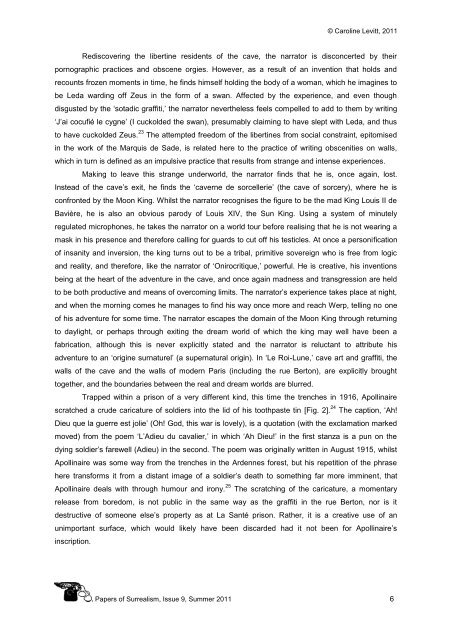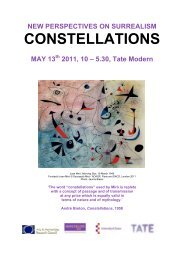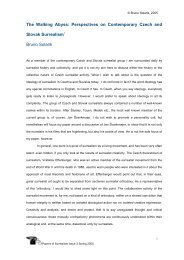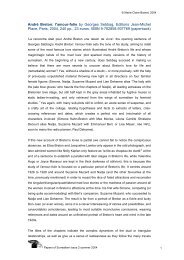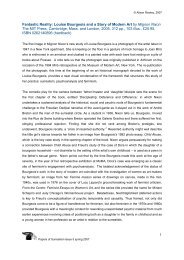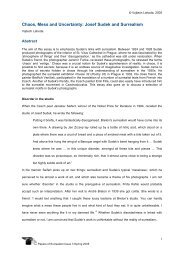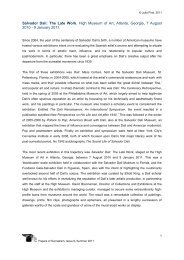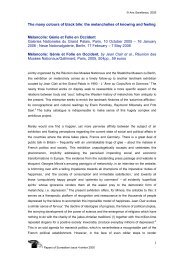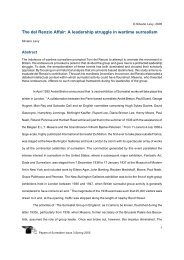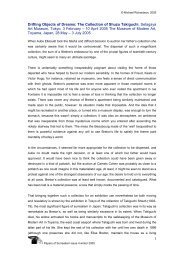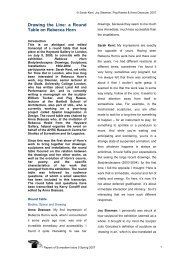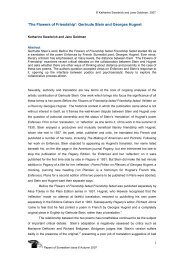From the Walls of Factories to the Poetry of the Street: Inscriptions ...
From the Walls of Factories to the Poetry of the Street: Inscriptions ...
From the Walls of Factories to the Poetry of the Street: Inscriptions ...
You also want an ePaper? Increase the reach of your titles
YUMPU automatically turns print PDFs into web optimized ePapers that Google loves.
© Caroline Levitt, 2011<br />
Rediscovering <strong>the</strong> libertine residents <strong>of</strong> <strong>the</strong> cave, <strong>the</strong> narra<strong>to</strong>r is disconcerted by <strong>the</strong>ir<br />
pornographic practices and obscene orgies. However, as a result <strong>of</strong> an invention that holds and<br />
recounts frozen moments in time, he finds himself holding <strong>the</strong> body <strong>of</strong> a woman, which he imagines <strong>to</strong><br />
be Leda warding <strong>of</strong>f Zeus in <strong>the</strong> form <strong>of</strong> a swan. Affected by <strong>the</strong> experience, and even though<br />
disgusted by <strong>the</strong> „sotadic graffiti,‟ <strong>the</strong> narra<strong>to</strong>r never<strong>the</strong>less feels compelled <strong>to</strong> add <strong>to</strong> <strong>the</strong>m by writing<br />
„J‟ai cocufié le cygne‟ (I cuckolded <strong>the</strong> swan), presumably claiming <strong>to</strong> have slept with Leda, and thus<br />
<strong>to</strong> have cuckolded Zeus. 23 The attempted freedom <strong>of</strong> <strong>the</strong> libertines from social constraint, epi<strong>to</strong>mised<br />
in <strong>the</strong> work <strong>of</strong> <strong>the</strong> Marquis de Sade, is related here <strong>to</strong> <strong>the</strong> practice <strong>of</strong> writing obscenities on walls,<br />
which in turn is defined as an impulsive practice that results from strange and intense experiences.<br />
Making <strong>to</strong> leave this strange underworld, <strong>the</strong> narra<strong>to</strong>r finds that he is, once again, lost.<br />
Instead <strong>of</strong> <strong>the</strong> cave‟s exit, he finds <strong>the</strong> „caverne de sorcellerie‟ (<strong>the</strong> cave <strong>of</strong> sorcery), where he is<br />
confronted by <strong>the</strong> Moon King. Whilst <strong>the</strong> narra<strong>to</strong>r recognises <strong>the</strong> figure <strong>to</strong> be <strong>the</strong> mad King Louis II de<br />
Bavière, he is also an obvious parody <strong>of</strong> Louis XIV, <strong>the</strong> Sun King. Using a system <strong>of</strong> minutely<br />
regulated microphones, he takes <strong>the</strong> narra<strong>to</strong>r on a world <strong>to</strong>ur before realising that he is not wearing a<br />
mask in his presence and <strong>the</strong>refore calling for guards <strong>to</strong> cut <strong>of</strong>f his testicles. At once a personification<br />
<strong>of</strong> insanity and inversion, <strong>the</strong> king turns out <strong>to</strong> be a tribal, primitive sovereign who is free from logic<br />
and reality, and <strong>the</strong>refore, like <strong>the</strong> narra<strong>to</strong>r <strong>of</strong> „Onirocritique,‟ powerful. He is creative, his inventions<br />
being at <strong>the</strong> heart <strong>of</strong> <strong>the</strong> adventure in <strong>the</strong> cave, and once again madness and transgression are held<br />
<strong>to</strong> be both productive and means <strong>of</strong> overcoming limits. The narra<strong>to</strong>r‟s experience takes place at night,<br />
and when <strong>the</strong> morning comes he manages <strong>to</strong> find his way once more and reach Werp, telling no one<br />
<strong>of</strong> his adventure for some time. The narra<strong>to</strong>r escapes <strong>the</strong> domain <strong>of</strong> <strong>the</strong> Moon King through returning<br />
<strong>to</strong> daylight, or perhaps through exiting <strong>the</strong> dream world <strong>of</strong> which <strong>the</strong> king may well have been a<br />
fabrication, although this is never explicitly stated and <strong>the</strong> narra<strong>to</strong>r is reluctant <strong>to</strong> attribute his<br />
adventure <strong>to</strong> an „origine surnaturel‟ (a supernatural origin). In „Le Roi-Lune,‟ cave art and graffiti, <strong>the</strong><br />
walls <strong>of</strong> <strong>the</strong> cave and <strong>the</strong> walls <strong>of</strong> modern Paris (including <strong>the</strong> rue Ber<strong>to</strong>n), are explicitly brought<br />
<strong>to</strong>ge<strong>the</strong>r, and <strong>the</strong> boundaries between <strong>the</strong> real and dream worlds are blurred.<br />
Trapped within a prison <strong>of</strong> a very different kind, this time <strong>the</strong> trenches in 1916, Apollinaire<br />
scratched a crude caricature <strong>of</strong> soldiers in<strong>to</strong> <strong>the</strong> lid <strong>of</strong> his <strong>to</strong>othpaste tin [Fig. 2]. 24 The caption, „Ah!<br />
Dieu que la guerre est jolie‟ (Oh! God, this war is lovely), is a quotation (with <strong>the</strong> exclamation marked<br />
moved) from <strong>the</strong> poem „L‟Adieu du cavalier,‟ in which „Ah Dieu!‟ in <strong>the</strong> first stanza is a pun on <strong>the</strong><br />
dying soldier‟s farewell (Adieu) in <strong>the</strong> second. The poem was originally written in August 1915, whilst<br />
Apollinaire was some way from <strong>the</strong> trenches in <strong>the</strong> Ardennes forest, but his repetition <strong>of</strong> <strong>the</strong> phrase<br />
here transforms it from a distant image <strong>of</strong> a soldier‟s death <strong>to</strong> something far more imminent, that<br />
Apollinaire deals with through humour and irony. 25 The scratching <strong>of</strong> <strong>the</strong> caricature, a momentary<br />
release from boredom, is not public in <strong>the</strong> same way as <strong>the</strong> graffiti in <strong>the</strong> rue Ber<strong>to</strong>n, nor is it<br />
destructive <strong>of</strong> someone else‟s property as at La Santé prison. Ra<strong>the</strong>r, it is a creative use <strong>of</strong> an<br />
unimportant surface, which would likely have been discarded had it not been for Apollinaire‟s<br />
inscription.<br />
Papers <strong>of</strong> Surrealism, Issue 9, Summer 2011 6


